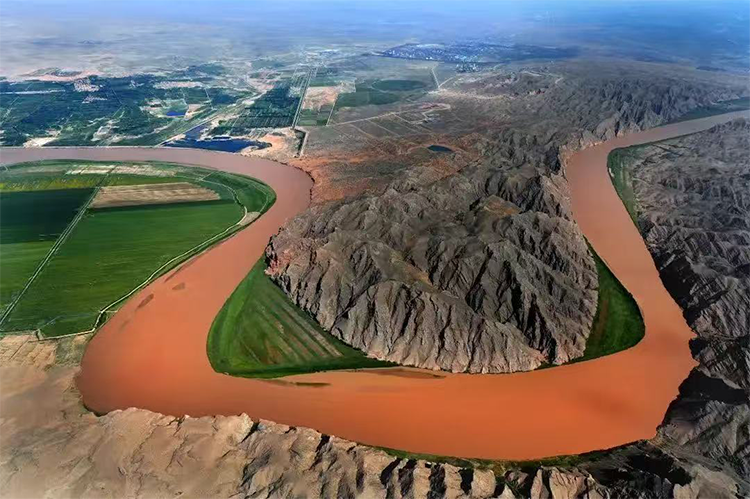Boat Cruise Along Qingtongxia Grand Canyon: Explore Western Xia Pagodas & Dam
Introduction:
When the Yellow River breaks through the last ridges of the Helan Mountains and carves an 8.6-kilometer cleft across the Ningxia plain, Qingtongxia is born—the so-called “Little Three Gorges” of the Yellow River. Here a dramatic canyon, 108 Western Xia pagodas set like stars on rust-red cliffs, and one of New China’s first large hydraulic projects converge into a living epic. Boarding a boat through the sheer-walled Ten-Mile Gorge, you’ll encounter the river’s raw power, layers of history, and humanity’s age-old effort to tame the waters.
1. World-class Canyon Spectacle and a Cultural Tapestry
The narrow “two mountains, one river” configuration concentrates the Yellow River’s finest upper-reach scenery: the southern Niushou Hill and the northern Helan foothills press nearly vertical cliffs together until the channel narrows to under a hundred meters. Sunlit rapids gleam with a bronze sheen—hence Qingtongxia’s name. As a national 4A scenic area and an important water conservation landscape, Qingtongxia is also a three-layered cultural site where Western Xia Buddhist heritage, modern engineering achievement, and ancient flood-control legends meet.
Highlights:
– China’s largest lama pagoda complex: The 108 pagodas cling to the mountainside in a perfect triangular array. Original Western Xia foundations and Ming–Qing restorations bear witness to over 900 years of Buddhist practice here.
– The opening chapter of New China’s waterworks: Completed in 1958, the Qingtongxia hydraulic project has long been celebrated as the “first dam of the Yellow River,” still essential to irrigation across the Ningxia plain.
– Living Dayu (Great Yu) culture: At the canyon’s eastern mouth the Dayu Cultural Park uses towering sculpture and a 3D theater to retell the ancient legend of river guidance and piling stones—underscoring Qingtongxia’s role in China’s long water-control history.
2. An Immersive Journey Through Time
Boat Cruise (best season May–October)
Board a traditional-style tour boat and travel upstream from the dam on a geological and cultural time travel. In about 15 minutes you’ll reach the Ten-Mile Gorge—the most dramatic stretch of the river. The roar of high water in summer is a world away from the placid, red-cliff reflections of autumn and winter. The route ends at the foot of the 108 pagodas; disembark and follow a wooden boardwalk for close-up views. Each pagoda bears tantric Western Xia symbols carved into its surface, and fragments of Xixia-script scriptures were once excavated from the tallest No.1 pagoda.
Hydraulic Works Exploration
Your ticket also grants access to the dam exhibition hall where massive generator sets rattle underfoot, echoing the determination of 1950s builders. If you visit during the flood release season (July–August), stand on the observation platform and feel up to 8,000 cubic meters per second of water thunder through the gates—an awe-inspiring demonstration of the Yellow River’s might.

3. Practical Visitor Guide
Getting There
– From Yinchuan: Drive west about 1.5 hours via the G6 Beijing–Tibet Expressway; or catch a tourist shuttle from New Moon Plaza (departures daily at 08:00 and 13:00, ticket CNY 35).
– By rail: Take a high-speed train to Qingtongxia Station and taxi 20 minutes to the east gate (about CNY 30).
Tickets and Suggested Route
– Basic package CNY 120: includes canyon boat cruise (40 minutes), the 108 pagoda area, and the dam observation platform.
– Recommended itinerary: Morning at the Dayu Cultural Park (1 hour) → boat to the 108 pagodas (2 hours) → dam exhibition hall in the afternoon (1 hour). Plan for 5–6 hours total.
Little-Known Experiences
Head to the 108 pagodas at dawn: when mist clings to the cliffs the pagoda group creates a rare “Buddha-light-through-stupas” spectacle. For deeper context on Western Xia culture, reserve a specialist guide (Chinese and limited English service available; book at least 3 days in advance).
4. Food, Lodging and Seasonal Tips
Taste the Yellow River
At the park exit the Qingtongxia Fisherfolk Village serves fresh Yellow River carp—steamed carp is highly recommended, paired with local goji berry wine. In summer try the local sandy-plain lamb hand-eaten style; the meat is tender and surprisingly mild thanks to the mineral-rich grasses of the canyon pastures.
Where to Stay
– Convenient option: the Hydraulics Hotel (3-star) inside the scenic area offers dam views from your window.
– Cultural stay: a 30-minute drive to Wuzhong city brings you to Hui-minority guesthouses for a cultural homestay, including traditional therapeutic soups and local wellness practices.
Peak-season Advice
During National Day (Oct 1–7) boat waits can exceed one hour—arrive before 07:30 to beat the lines. In winter (Dec–Feb) some boats suspend operation, but snow-dusted pagodas present an otherworldly “Sasakian Angkor” atmosphere.

Conclusion:
Qingtongxia’s power lies in its ability to satisfy every kind of curiosity—geological spectacle, historical mystery, and modern engineering all at once. As the boat turns to return, glance back at the 108 pagodas: they stand like silent sentinels over the surging Yellow River and the gleaming gates of the dam, telling an enduring tale of humanity’s love–hate dance with the river. This is the Yellow River spirit of Ningxia.


